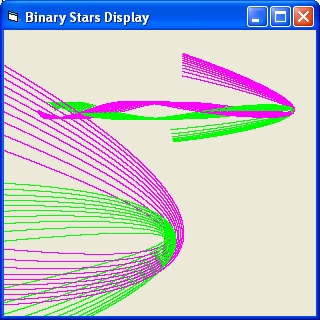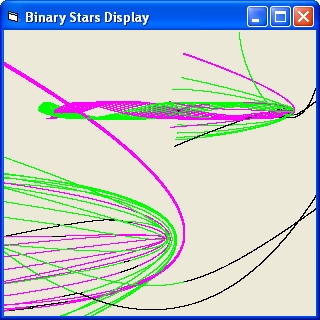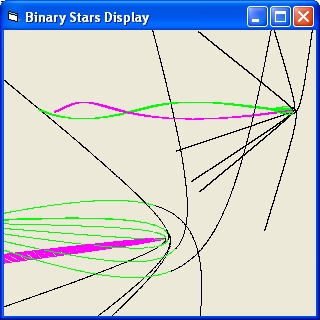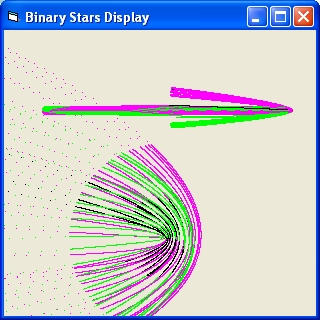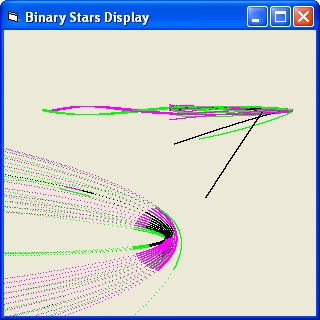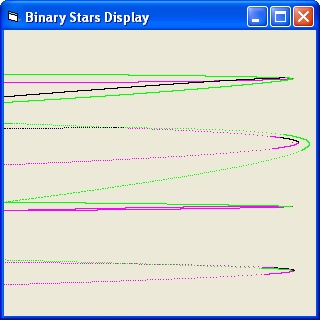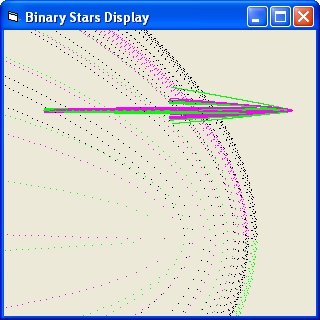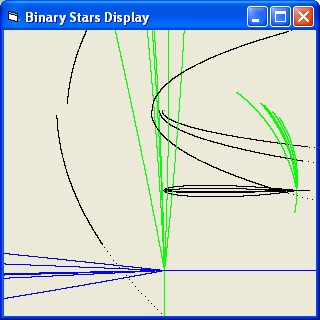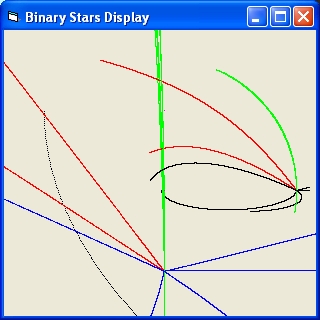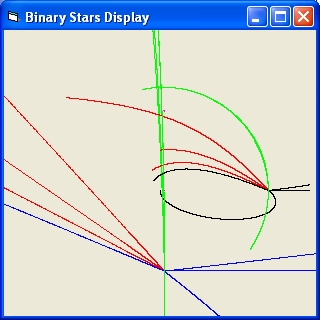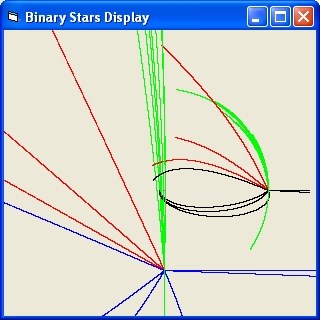- The small star will immediate collide with one of the binary stars
- The small star will make a dance around the binary stars and then collide.
- The small star will make a dance around the binary stars and then be ejected
- The small star will immediate be ejected
The initial speeds of the single star m3 is below the escape velocity of the binary pair (M = m1+m2 v = sqr(2*G*M/R)).
In order to evaluate each simulation two parameters vlimit and rlimit are used
- vlimit is defined by using the escape speed v^2 = 2 * G * M/R
with r = v * dt we get: v^2 = 2 * G * M/(v * dt)
This results in : vlimit = (2 * G * M/dt) ^ 1/3 - rlimit is defined as: vlimit / dt
*m1
x
x alpha
x <---
----------x-----------------------------------------------------*m3
x
x
x
m2* Figure 1
|
- The first simulation describes the situation where m1 = m0, m2 = m0 and m3 = 0.001 * m0
distance between m1 and m2 = 10000 km, vlimit = 235484, rlimit = 4,78 ,delta t = 0,0000203 and revolution time = 12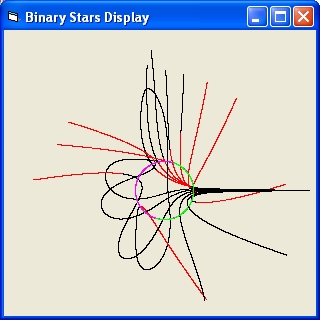
Figure 2 angle n stars rmin 13 rmin 23 v1 max v2 max v3 max v1 v2 v3 v esc 0 3 653 9333 2592 2580 18328 2586 2580 4519 4675 10 3 136 9848 2614 2579 41932 2583 2579 6486 5102 20 2 3 10002 2600 2576 258151 2470 2576 258151 265222 30 3 194 9754 2580 2580 39091 2580 2580 6509 5312 40 3 599 9281 2581 2580 23261 2581 2580 5755 5310 50 3 1111 8778 2583 2580 17726 2583 2580 4892 5282 60 3 1638 8319 2583 2580 15034 2583 2580 3893 5171 70 3 2099 7903 2583 2580 13517 2580 2578 2091 4645 80 3 2438 7505 2583 2579 12565 2575 2576 792 4949 90 3 124 5547 2587 2586 47104 2562 2567 6847 5287 100 3 15654 25000 2576 2575 2929 2576 2575 2929 5249 110 3 15325 25000 2576 2575 2969 2576 2575 2969 5278 120 3 15184 25000 2576 2575 3009 2576 2575 3009 5293 130 3 15244 25000 2576 2576 3042 2575 2576 3042 5291 140 3 4041 7 2585 2678 187485 2568 2565 7726 5297 150 3 5610 468 2584 2583 23061 2567 2567 7709 5245 160 3 7451 949 2581 2583 15582 2573 2577 5964 4819 170 3 8523 1469 2580 2586 12201 2579 2581 1779 5280 180 3 9333 653 2580 2592 18328 2580 2586 4519 4675 - Column 11 shows the escape velocity at the end of the simulation cycle.
- Column 10 shows the speed of m3 at the end of the simulation. Certain numbers in that column are in red . The reason is that the final speed is higher than the escape velocity.
- Column 1 shows the angle in increments of 10 degrees.
- Column 2 shows the number of objects at the end of the simulation cycle. For angle 20 the number is two. That means m3 collided with m1 or m3. The final speed is also very large.
- columns 3 shows the minimum distance between m3 and m1. For angle 20 the value 3 is very small that means m3 collided with m1
- columns 4 shows the minimum distance between m3 and m2. For angle 140 the value 7 is very small that means m3 almost collided with m1
- The collums 5, 6 and 7 show the maximum speed of m1, m2 or m3.
- The collums 8, 9 and 10 show the speed of m1, m2 or m3 at the end of each simulation cycle.
- The second simulation describes the situation where m1 = m2 = m0 and m3 = 0.001 * m0
The distance between m1 and m2 = 1 AU = 149600000 km, vlimit = 1925, rlimit = 0,00047, revolution time = 22315464
The masses of the stars selected is realistic. See List of massive stars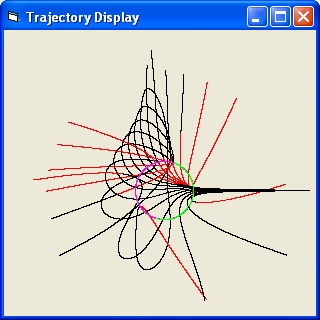
Figure 3 angle n stars rmin 13 rmin 23 v1 max v2 max v3 max v1 v2 v3 v esc 0 3 0,065 0,933 21,19 21,09 149,85 21,14 21,09 36,94 38,22 10 3 0,013 0,984 21,37 21,08 342,83 21,12 21,08 53,02 41,71 20 2 0 1 21,26 21,06 2110,61 20,2 21,06 2110,61 2168,42 30 3 0,019 0,975 21,09 21,09 319,6 21,09 21,09 53,21 43,43 40 3 0,059 0,928 21,1 21,09 190,17 21,1 21,09 47,05 43,41 50 3 0,111 0,877 21,11 21,09 144,93 21,11 21,09 40 43,18 60 3 0,163 0,831 21,12 21,09 122,92 21,12 21,09 31,83 42,27 70 3 0,209 0,79 21,12 21,09 110,52 21,09 21,08 17,09 37,97 80 3 0,243 0,75 21,12 21,09 102,73 21,05 21,06 6,48 40,46 90 3 0,012 0,554 21,15 21,15 385,12 20,95 20,99 55,98 43,23 100 3 0,273 0,312 21,14 21,14 92,71 21,14 21,14 16,99 41,25 110 3 0,279 0,136 21,13 21,09 119,94 21,05 21,04 36,89 43,33 120 3 0,292 0,053 21,13 21,09 184,9 21,02 21 45,69 42,92 130 3 0,326 0,012 21,13 21,18 374,46 21 20,98 53,74 42,86 140 3 0,404 0 21,13 21,9 1532,85 20,99 20,97 63,17 43,31 150 3 0,561 0,046 21,12 21,12 188,55 20,98 20,99 63,03 42,88 160 3 0,745 0,094 21,1 21,12 127,4 21,04 21,07 48,76 39,4 170 3 0,852 0,146 21,09 21,14 99,75 21,08 21,1 14,55 43,17 180 3 0,933 0,065 21,09 21,19 149,85 21,09 21,14 36,94 38,22 - The third simulation describes the situation where m1 = m2 = 100 * m0 and m3 = 0.5 * m0
distance between m1 and m2 = 5984000 km, vlimit = 96264, rlimit = 2864,24, revolution time = 17852
The masses of the stars selected is realistic. See List of massive starsFigure 3 angle n stars rmin 13 rmin 23 v1 max v2 max v3 max v1 v2 v3 v esc 0 3 113300 1628819 1090 1075 15137 1031 1037 3437 2560 10 3 675874 2344858 1065 1073 5976 1040 1034 2958 2481 20 3 1720968 3682166 1066 1068 3816 1049 1047 1098 2363 30 3 1054951 4913807 1072 1062 4526 1067 1062 779 2400 40 3 486069 5483155 1083 1058 6636 1069 1058 1933 2197 50 3 124789 5844170 1115 1055 13723 1057 1055 2846 2515 60 2 1525 5986932 1551 1053 102671 1551 1052 102671 131919 70 3 63865 5907657 1060 1056 21174 1051 1056 2937 2556 80 3 245573 5682892 1055 1057 11220 1054 1057 2686 2547 90 3 491499 5423305 1057 1058 8198 1057 1058 2411 2553 100 3 759536 5183228 1060 1058 6783 1060 1058 2125 2566 110 3 1012616 4970785 1063 1059 5997 1063 1059 1804 2571 120 3 1215778 4776583 1066 1060 5520 1066 1060 1393 2534 130 3 1341902 4585266 1067 1060 5210 1054 1056 161 2233 140 3 1381950 893236 1068 1060 5974 1045 1043 1943 2530 150 3 1355603 190866 1070 1063 12083 1039 1034 2589 2470 160 3 1319159 18324 1072 1126 38162 1038 1031 2955 2475 170 3 1363818 5022 1074 1265 73075 1038 1031 3203 2503 180 3 1628819 113300 1075 1090 15137 1037 1031 3437 2560 - The fourth simulation describes the situation where m1 = m2 = 100 * m0 and m3 = 0.5 * m0
distance between m1 and m2 = 149600000 km, vlimit = 19252, rlimit = 71606, revolution time = 2231546
angle n stars rmin 13 rmin 23 v1 max v2 max v3 max v1 v2 v3 v esc 0 3 2832507 40720485 218 215 3027 206 207 687 512 10 3 16896874 58621461 213 214 1195 208 206 591 496
